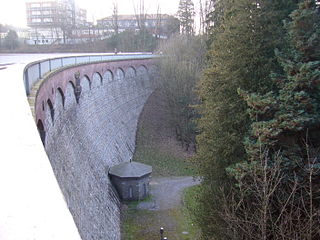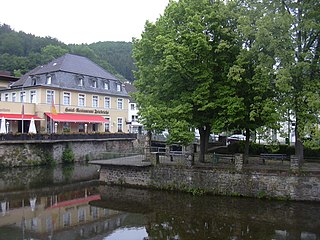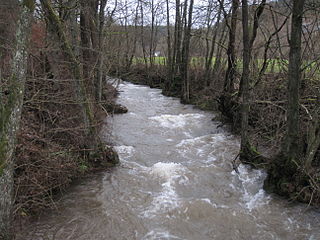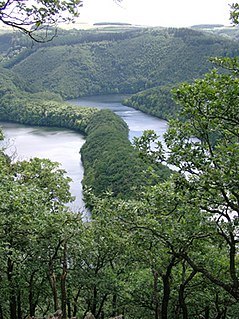
Ahr is a river in Germany, a left tributary of the Rhine. Its source is at an elevation of approximately 470 metres (1,540 ft) above sea level in Blankenheim in the Eifel, in the cellar of a timber-frame house near the castle of Blankenheim. After 18 kilometres (11 mi) it crosses from North Rhine-Westphalia into Rhineland-Palatinate.

The Rur or Roer is a major river that flows through portions of Belgium, Germany and the Netherlands. It is a right (eastern) tributary to the Meuse. About 90 percent of the river's course is in Germany.

The Möhne Reservoir, or Moehne Reservoir, is an artificial lake in North Rhine-Westphalia, some 45 km east of Dortmund, Germany. The lake is formed by the damming of two rivers, Möhne and Heve, and with its four basins stores as much as 135 million cubic metres of water.

The Eschbach Dam was the first dam to be built in Germany for drinking water supply. It is located in Remscheid, North Rhine-Westphalia, Germany. With its opening in 1891, this pioneer work of hydraulic engineering was a milestone in the economic development of the city of Remscheid.

The Sorpe Dam is a dam on the Sorpe river, near the small town of Sundern in the district of Hochsauerland in North Rhine-Westphalia, Germany.
The Rur Eifel lies in the district of Düren in the German state of North Rhine-Westphalia, and is a local recreation area from the regions of Cologne, Aachen, Düsseldorf, Krefeld, Mönchengladbach and Bonn. Its name comes from the river Rur and the Eifel Mountains.
The Zitter Forest is located in the Eifel region in the German district of Euskirchen and in the Belgian province of Liège (Wallonia). Its highest point is 692 m above sea level (NN).

The Daniel-Johnson Dam, formerly known as Manic-5, is a multiple-arch buttress dam on the Manicouagan River that creates the annular Manicouagan Reservoir. The dam is composed of 14 buttresses and 13 arches and is 214 km (133 mi) north of Baie-Comeau in Quebec, Canada. The dam was constructed between 1959 and 1970 for the purpose of hydroelectric power production and supplies water to the Manic-5 and Manic-5-PA power houses with a combined capacity of 2,596 MW. The dam is 214 m (702 ft) tall, 1,314 m (4,311 ft) long and contains 2,200,000 m3 of concrete, making it the largest dam of its type in the world.

The Olef is a river in Liège, Belgium and North Rhine-Westphalia, Germany. It is 27.9 kilometres long and a left-hand tributary of the Urft. It flows through the Eifel Mountains in the western part of the Germany and eastern part of Belgium.

The Urft is a 46.4-kilometre-long (28.8 mi) right-hand tributary of the Rur in the county of Euskirchen in the German state of North Rhine-Westphalia. It flows through the village of Urft in the municipality of Kall. The Urft rises in the North Eifel region of the Eifel Mountains.

The Urft Dam is a 58.50 metre high dam in the southwestern part of the state of North Rhine-Westphalia in Germany. It was built in 1905. The dam impounds the River Urft in the district of Euskirchen to create the Urft Reservoir (Urftstausee), 2.16 km² in area. The reservoir is also called the Urftsee.

The Haba River Shankou Dam is a concrete-face rock-fill dam on the Haba River, a tributary of the Irtysh River. It is located in Habahe County of the Xinjiang Uyghur Autonomous Region in China. The primary purpose of the dam is hydroelectric power generation, flood control and water supply for civil and irrigation use. It supports a 25.2 MW power station.

Little Rock Dam, also known as Littlerock Dam, or officially as Little Rock-Palmdale Dam, is a concrete gravity dam on Little Rock Creek in Los Angeles County, California, about 5 mi (8.0 km) south of Palmdale. The dam and Little Rock Reservoir are owned by the Palmdale Water District and Littlerock Creek Irrigation District and are used for agricultural and municipal water supply and flood control.

The Perlenbach Valley is the valley of the Perlenbach stream in the Eifel mountains in the countries of Belgium and Germany. The Perlenbach itself is a tributary of the Rur. The Perlenbach Valley is host to two outstanding, cultural-historical nature reserves along the state border which have a total area of 398 ha.

Schöneseiffen is a village southwest of Schleiden in the county of Euskirchen| in the German state of North Rhine-Westphalia. The Dieffenbach stream rises north of the village. Schöneseiffen has a population of about 415. Schöneseiffen has sports field, a Bürgerhaus and a youth centre.

The Platißbach is a roughly seven-kilometre-long (4.3 mi), southern and orographically right-hand tributary of the River Olef in the municipality of Hellenthal in Germany.























